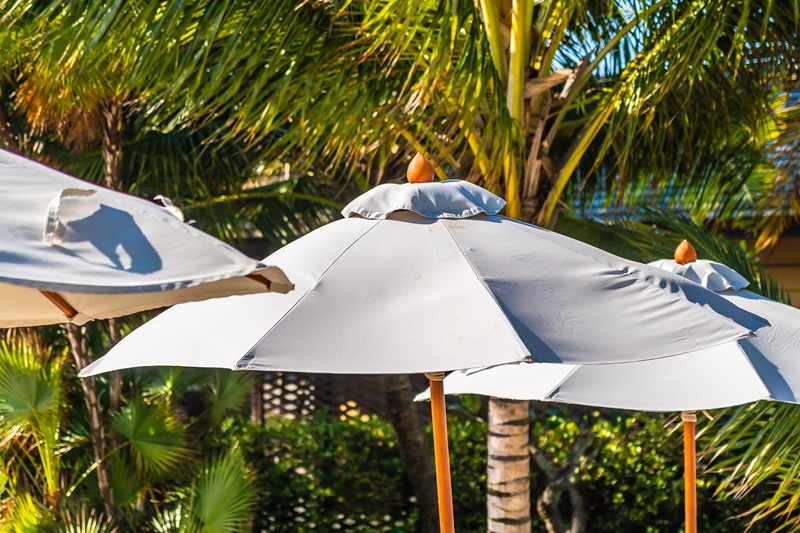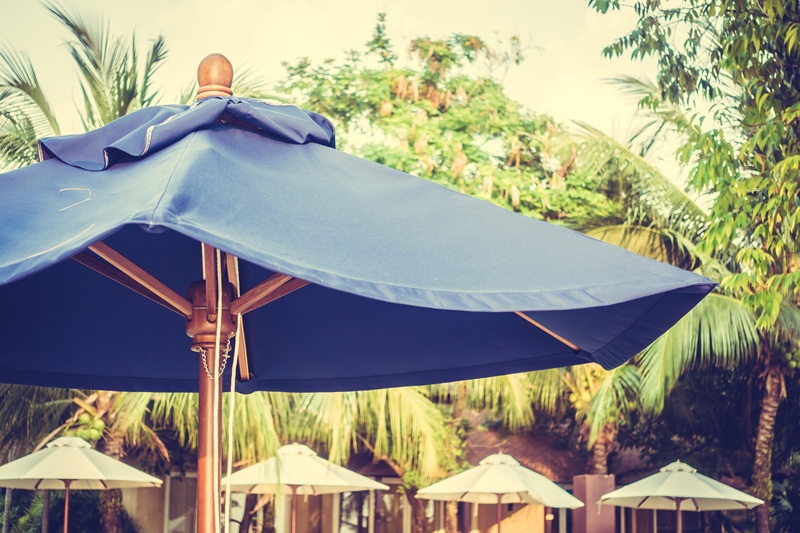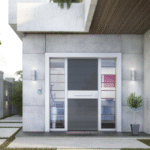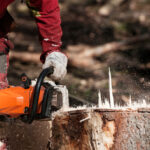Have you ever thought that what some people call outdoor furniture could help save our world? Could this shining market umbrella shielding your grill activities for the weekend be a part of the solution instead of the problem? Will going green actually mean saving money through outdoor design-wise?
There are various aspects of this guide that will cover what truly constitutes an environmental market umbrella, the technology disruption in outdoor spaces today, and help you choose the right solution for your green shading needs. Whether it be for a domestic patio space, a busy cafe, or a community space, you’ll get a lot of practical insights along with what to avoid so that outdoor spaces can truly become masterpieces in green practice. So, let’s understand what it takes to turn outdoor areas into a solution.
What Makes A Market Umbrellas Truly Eco-Friendly?
Understanding Sustainable Materials and Processes
Not every green umbrella in the market shares a similar story and knowing that an eco-friendly umbrella is far more than just marketing gimmicks. The actual sustainability begins from the source-the bamboo frames, recycled aluminium poles, and organic cotton or recycled polyester canopies. The manufacturing process itself is important-sustainable companies use renewable energy in the factories, conserve water, and produce waste-free.
Transportation carbon footprint is also another crucial factor. Australian-made umbrellas have drastically cut emissions compared to imports. The clever manufacturers also design their products in such a manner that it is modular, repairable, and has enhanced longevity.
Further thoughts on what qualifies as an eco-friendly umbrella? They consider the whole supply chain, including fair labour practices along with responsible material sourcing and communication about their environmental impact. Search for firms publishing sustainability reports and can identify the source of their materials apparently through ethical means when rating your options.
Lifecycle of Eco-Conscious Outdoor Furniture
Knowing the full life cycle of your market umbrella determines whether your choice is genuinely sustainable. Life cycle means from extraction and production to use and maintenance down to disposal or recycling. Each of these stages provides ways to minimize environmental impact.
End-of-life thinking is where most of the products fail. Truly sustainable have been designed to disassemble using materials that would either be recycled, composted, or repurposed. Some innovative companies even put back schemes in place, ensuring their disposed products are properly taken care of.
Certifications And Standards to Look For
Chances are that eco- certifications are confusing. But it gets easier if you know which standards matter. Forest Stewardship Council (FSC) certification essentially means that the timber components are responsibly sourced by the manufacturer’s own definition, while Global Organic Textile Standard (GOTS) certification stands for organic fabric canopies. You can also look for Cradle to Cradle certification for overall sustainability; it lists several criteria for social and environmental accountability under which the product is assessed.
Don’t overlook social certifications either: Fair Trade certification means that labour is ethical; and a B Corporation status refers to the company meeting high social and environmental performance standards. When several certifications stand together, you can rest assured you are putting your money into really sustainable products.
The Future Outlook-Promising Innovations in Umbrella Design

New Innovative Umbrella Technologies Transforming Outdoor Spaces
The umbrella industry market is undergoing some technical revolution to make sustainability cheap and good looking. Photocatalytic coatings that decompose dirt and pollutants upon exposure to sunlight allow canopies to self-clean. Such state-of-the-art designs of umbrellas require less frequent washing, resulting in less consumption of water and erasing the need for toxic cleaning agents.
Other IoT technologies will allow the umbrella to communicate with weather applications, which will allow the umbrella to adjust itself through the day for optimal shade and protection. This smart functionality reduces wear and tear on the umbrella while maximizing user comfort, thus proving that sustainability and convenience can indeed go hand in hand.
Some features that are solar-powered and energy generating
Solar technology has turned ordinary market umbrellas into portable power plants, unlike their earlier ancestors that offered shade. Wherever one finds a good design for panel-on-canopy interface integration, clean energy generation is possible without disrupting the aesthetics of a structure. These dozens of umbrellas can produce enough energy to charge devices, illuminate LED lights in the evening while entertaining outdoors, and even power small speakers or fans.
Solar-powered umbrellas can go beyond just energy generation: they can incorporate a huge variety of integrated amenities, such as USB charging ports, integrated wireless charging pads, and smart home technologies. All of these factors combined make these umbrellas ideally suitable for the predominantly sunny weather conditions in Australia, hence making solar gardens an excellent option for investments for both private homes and commercial installations.
Adaptive to Weather Conditions
Groundbreaking fabrics technologies are producing intelligent umbrellas that respond to the weather changes. A thermochromic material is one that changes colour with temperature, which gives visual cues about heat levels while reflecting more sunlight on hotter days. Such adaptive response reduces the heat absorption keeping naturally cooler shaded areas.
Self-healing polymers are the newest in the game of umbrellas. These materials can self-mend minuscule rips and punctures, significantly lengthening the lifespan of a product. Coupled with UV-resistant finishings that prevent fading and degradation, these smart materials guarantee that your investment keeps working and looking good for many years.
How to Choose an Eco-Friendly Market Umbrellas for Your Space
Residential Gardens and Patios
An eco-friendly umbrella for the home is one that can be bought after weighing sustainability against practical requirements. Usually, cantilever umbrellas are fabricated of recycled aluminium and stand up quite well in the traditional Australian backyard, allowing re-adjustment without having to move around the furniture underneath. The offset design is great around pools and entertaining areas where a central pole would hinder movement.
Indeed, colour impacts both aesthetics and sustainability. Light colours reflect heat better, keeping spaces cooler naturally, while darker shades offer better UV protection benefits. Many eco-friendly manufacturers now use solution-dyed fabrics where the colour is added during the fibre production process, producing better fade resistance without the harmful use of chemicals in the treatment.
Commercial Hospitality Venues
The hospitality industry faces its special issues that require tough but appealing solutions that can withstand heavy traffic. Commercial-grade eco-friendly market umbrellas are generally outfitted with reinforced frames, heavy-duty fabrics, and advanced anchoring systems. Among the busy cafés and restaurants, it would be best to get those models that have antimicrobial fabric treatments using natural silver ions rather than synthetic chemicals.
Wind ratings become critical for commercial installations. Australia sets forth specific certifications needed for public spaces, and sustainable options now meet and exceed those requirements. Consider umbrellas with automatic wind sensors that prevent damage during sudden weather changes, consequently trimming replacement costs and environmental impact.
Public Spaces and Community Areas
Public installations demand to have outstanding durability along with the environmental quality of responsibility. Setting recycled materials and end-of-life recyclability will become part of the tender specifications by councils and community entities. Vandal-resistant designs might utilize powder-coated recycled steel frames with ripstop fabric made from ocean plastic, addressing the dual priorities of sustainability and practicality.
Aesthetic appeal of a sustainable product indeed engages the community. A small educational plaque explaining the sustainable aspects of the umbrellas, a QR code linking to the information about sustainability, even composting stations under the umbrellas could elevate an otherwise mundane shade structure to being a form of environmental education.
Coastal versus Inland Considerations Across Australia
The variegated climates of Australia require various considerations for sustainable umbrella selection. Due to the need for enhanced corrosion resistance, coastal-grade options make the specification of recycled marine-grade aluminium or specially treated bamboo a necessity. Salt-resistant coatings on the fabrics using eco-nanomaterials are ways of protecting from degradation without harming the environment.
Wind patterns are totally different for coastal areas and those located inland. Coastal areas need umbrellas that withstand the continuous sea breezes, while those in the inland areas may experience gusty wind sudden bursts. Understanding your local conditions helps select umbrellas that last longer, reducing replacement frequency and environmental impact.
The Materials that Matter-Painting Deep into Sustainable Options

Recyclable and Recycled Frameworks
The framework forms the backbone of your umbrella, and material choice contributes significantly to sustainability. Recycled aluminium has become the most popular gold standard with very good strength-to-weight-ratio properties while using 95% less energy than virgin aluminium production. These frames resist corrosion naturally, eliminating the need for toxic protective coatings.
Among the most recent innovations in frames include recycled ocean plastic composites. These compellingly new materials turn maritime waste into strong and lightweight structures. Some manufacturers combine ocean plastics with recycled carbon fibre coming from the aerospace industry, resulting in incredibly strong frames and interesting stories of sustainability behind them.
Natural vs Synthetic Canopy Fabrics
Sustainability advocates often get torn in a debate over which is better, natural or synthetic fabrics, even when both present environmental advantages if chosen carefully. The alternatives consist of soluble, biodegradable fabrics, like organic cotton and hemp. They are not processed very much and breathe and feel nice, usually needing more replacements in hostile environments.
New biobased synthetics-with their promising qualities of bridging the gap between natural and synthetic products- are derived from agricultural waste, algae or other renewable resources. This source has appropriated the performance advantages of synthetic kinds of fabrics and improved their biodegradability. The advancements in technology should bring with them the increased use of such innovative umbrellas in the years to come.
Biodegradable components and end of life planning
In fact, modern thinking produces umbrellas made to a design principled entirely on biodegradability. Wooden or bamboo poles, cotton canopies, and natural rubber fittings can theoretically go back to earth without poisonous residue. Normally, however, weather-proofing treatments make complete biodegradability problems.
As an example of practical compromise, modular design philosophy has individual components easily replaceable and recyclable. Manufacturers thus prolong the use of the product and at the same time make end-of-life disposal easier. The data in QR codes on products will highly increase connection to disassembly guidelines and local information on recycling.
Durability vs Sustainability: Finding the Balance
The durability-sustainability link is not always easy to assess. While it can certainly be said that products that survive longer tend to be more sustainable, the most durable products often demand finishes and components that raise serious questions about their environmental credentials. Products must be long-lasting-enough to justify the environmental costs associated with their construction yet not be over-engineered.
The strength lies in picking the right product fit for the intended use. For instance, in a protected area of a home, a biodegradable bamboo umbrella might withstand three years of use, but under windy conditions at a commercial site, it would not last even up to a few months. Choosing the right materials increases performance while advancing sustainability-the condition for failure, wastage, and early replacement is eliminated.
Maintenance Tips for Extended Lifespan
With regular maintenance, an umbrella’s lifetime is improved enormously, hence reducing the environmental costs of using that product. Simple things such as closing umbrellas during storms, routine cleaning with green products, and storing properly during winter increase the lifespan life of such products by as much as two times. Maintenance schedules should be created according to your locality-the coastal areas will require more regular cleaning for removal of salty deposits.
Consider upgradability when replacement is necessary. The technology and materials are ever improving, and newer models might be able to use significantly better sustainable offerings. Also, if a replacement is necessary, ensure proper recycling or repurposing of the old umbrella-many components can find new lives in garden projects or community initiatives.
Future Trends in Sustainable Outdoor Design and Market Umbrellas
Circular Economy Principles in Outdoor Furniture
Circular economy principles have increasingly been adopted in the outdoor furniture created to design products for more than one use cycle. Standardized parts will thus fit future umbrellas, allowing simple interchanging amongst brands, similar to what is happening in electronics today. Not only will standardization of components reduce waste, but it will also increase accessibility for repair.
Blockchain will enable the track of the material from source to disposal. Customers will scan QR codes that will detail the history of their umbrella’s material, manufacturing processes, and the carbon footprint. Such transparency will drive sustainable improvement.
Climate-Responsive Design Features
In this regard, future umbrellas may well respond to climate change challenges. High-end materials will reinforce during and adapt to extremely common weather events. Canopies may be under systems that cool beyond mere shade, incorporating misting systems or heat-absorbing phase-change materials.
Biomimetic designs inspired by nature will improve performance while reducing environmental impact. Perhaps an umbrella can mimic how tree canopies cool naturally or have structures inspired by desert plants’ heat management strategies.





